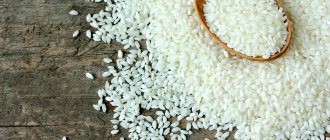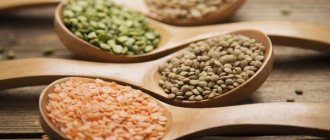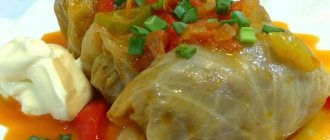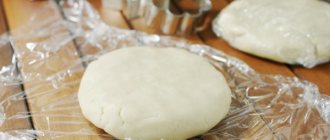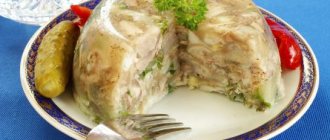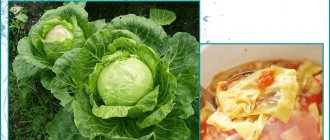Complexity
Average
Author of the publication
Natalia Glotova
NG
Sushi prepared at home will not be inferior in taste to restaurant sushi if you know how to properly prepare the sauce for rice. The taste of the future dish is largely determined by this ingredient, so it is advisable to pay special attention to the preparation of the dressing.
In this article we will look at some of the best recipes for preparing dressings for a traditional Japanese dish, which you will simply be delighted with.
Classic vinegar dressing recipe
What should the sauce be like?
It is important to understand that the dressing you prepare should be sufficiently sticky, only then will the rice hold its shape and the roll will not fall apart. Let's start our culinary story with a traditional recipe for making dressing.
Ingredients:
- rice vinegar - 3 tbsp. l.;
- salt – ½ tsp;
- granulated sugar - 2 tbsp. l.;
Cooking method:

- Take a small saucepan and mix all the available ingredients in it;
- Place the container on low heat and stir the contents constantly;
- When the granulated sugar is completely dissolved, cool the liquid;
- The finished dressing can be poured into a bottle and stored in the refrigerator for some time.
As you can see, making a classic “impregnation” for rice at home is very, very simple. But how can you be sure it was cooked correctly? Firstly, the indicated amount of ingredients is enough to process 2 cups of boiled rice, and secondly, the resulting mixture should not be too liquid, otherwise the rice will not stick together and you will be able to form a beautiful roll.
Rice dressing
Cooked sushi rice will turn out tasteless, because we cooked it without salt and spices. To ensure that it acquires the necessary taste, a dressing is prepared. The base is rice vinegar. It is not recommended to replace rice vinegar with other types. If you can’t buy it, you can make a dressing with white wine or apple cider vinegar.
The dressing should be poured into the rice in parts. The rice will need to be carefully mixed with a wooden spatula. There is no need to stir vigorously, otherwise the rice will turn into porridge. The dressing is poured into warm rice; only after dressing can the rice be completely cooled.
Here are some recipes for rice dressings:
Classic recipe
The classic filling is quite simple:
- 3 tablespoons rice vinegar;
- 0.5 teaspoon salt;
- 2 tablespoons of granulated sugar.
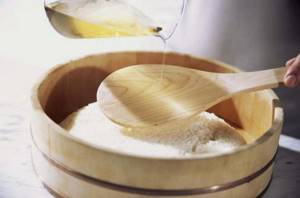
Mix all the listed ingredients in a small saucepan and place it on the stove. Turn the heat on to medium and cook, stirring constantly. Once the sugar and salt are completely dissolved, the dressing is ready. It is removed from the heat and cooled.
Advice! If necessary, the prepared dressing can be stored in the refrigerator in a tightly sealed container for 2-3 days.
The dressing prepared from the amount of ingredients indicated in the recipe is enough for 2 cups of already cooked rice. Properly prepared dressing has a sticky consistency and should help maintain the shape of the cooked sushi.
Add subtle notes of nut
Either peanuts or cashews are used as the base for preparing the mixture. The prepared “impregnation” has a very delicate consistency and a pronounced nutty aroma.
Ingredients:
- nut butter – 3 tbsp. l.;
- apple cider vinegar – 1 tbsp. l.;
- sesame oil – 2 tsp;
- soy sauce – 4 tbsp. l.;
- boiled water – 1 glass;
Cooking method:
- Place the required amount of paste in a saucepan and combine it with 100 ml of boiled water;
- Place the saucepan over low heat and stir the contents constantly;
- Then add another 100 ml of water and all other ingredients to the container;
- When the mixture thickens, remove it from the heat.
How to prepare sushizu?
Sushizu is one of the most delicious and delicate “sticky solutions” for sushi. If you consider yourself a true connoisseur of Japanese cuisine, you should definitely like this recipe. How to make sauce for boiled sushi rice at home?
Ingredients:
- kombu seaweed – 1 sheet;
- salt to taste;
- granulated sugar - 2 tbsp. l.;
- vinegar - 5 tbsp. l.
Cooking method No. 1:
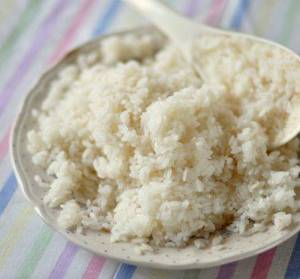
- Mix all ingredients in a separate bowl;
- Place the saucepan over very low heat;
- Be careful not to let the mixture boil;
- After about 5 minutes, remove the liquid from the heat and strain, removing any pieces of seaweed.
You can make sushizu a little differently. Thanks to the second option, you can prepare the mixture in literally five minutes.
Cooking method:
№2:
- Mix all available ingredients in a ceramic bowl;
- When the granulated sugar dissolves, put the cup in the microwave for just a couple of minutes;
- Then strain the liquid.
The rice mixture should cool thoroughly, then its “stickiness” will increase slightly. In addition, you can prepare sushizu in large quantities. The finished mixture can be stored in the refrigerator for about two weeks and nothing will happen to it.
What kind of rice is needed for sushi?
The main property of sushi rice is good stickiness, which determines the ease of formation and aesthetics of serving sushi and rolls. In addition, the rice must retain its structure and not become soggy when cooked.
Of the many varieties of Japanese rice, the Nishiki variety is used for making sushi - its rounded grains absorb a lot of water during cooking, so the cooked rice is easy to sculpt.
Rice suitable for sushi:
- white , that is, completely polished - brown rice (with bran shell) or black (“wild”) rice are not suitable for making sushi;
- round-grained , which means more sticky due to the large amount of starch.
definitely not suitable for making sushi. These types of rice remain crumbly after cooking and it is impossible to form them into a roll.
It is important to use fresh grains when preparing sushi so as not to spoil the taste and aroma of the dish with rice that has been stale for years.
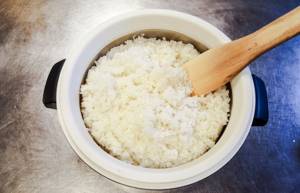
Apple cider vinegar sauce
How can you make a delicious sauce for sushi sticky rice? If the recipes suggested above do not appeal to you or are familiar to you, try making an “impregnation” based on apple cider vinegar. Of course, traditional recipes include rice vinegar, but once you try this version of the mixture, you definitely won’t refuse it.
Ingredients:
- apple cider vinegar – 4 tbsp. l.;
- regular vinegar - 1 tbsp. l;
- salt to taste;
- granulated sugar – 4 tbsp. l.
Rice dressing in the indicated quantity is calculated for approximately ½ kg of boiled rice.
Cooking method:
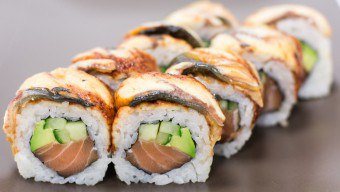
- Place a small saucepan on the stove in which combine all the listed ingredients;
- Stir the liquid all the time so that the granulated sugar dissolves quickly;
- The mixture should not boil, so as soon as you notice that it has reached the right temperature, remove the liquid from the heat.
You need to add the sauce to the rice in portions so as not to overdo it, otherwise the roll will not hold its shape. And as in previous versions, the mixture must be cooled well before use.
Dressing rice for sushi
Japanese cuisine is very popular these days. Having lunch or dinner with sushi or rolls has become the order of the day. There is a joke that making sushi at home is not only a fun activity, but also a “budget-saving” and “health-saving” activity, so let’s pay a little attention to an important component when making sushi - the dressing for rice, rolls and sushi.
Why do you need rice dressing? It gives rice for rolls and sushi not only the necessary taste, but also increases stickiness, so it will not fall apart.
Since no salt is added to rice during cooking, sushi rice dressing contains both salt and sugar. Vinegar plays the main role in seasoning rice. Rice vinegar can be found in specialized departments of stores where they sell other sushi ingredients. But what should you do if you still couldn’t buy rice vinegar? What can replace it?
Rice vinegar is usually replaced with white wine vinegar, grape vinegar, apple cider vinegar, or, at worst, table vinegar. Here you need to choose the right proportions so as not to spoil the taste of the rice.
You can try ready-made recipes and then adjust the amount of ingredients to taste.
Rice Vinegar Dressing Recipe
Ingredients:
- rice vinegar – 100 ml;
- sugar – 3 teaspoons;
- salt – 1 teaspoon.
Apple Cider Vinegar Recipe
Ingredients:
- apple cider vinegar – 2 tbsp. spoons;
- water – 3 tbsp. spoons;
- sugar – 2 teaspoons
- salt – 1 teaspoon.
Recipe with grape vinegar
Ingredients:
- grape vinegar - 4 tbsp. spoons;
- sugar – 3 teaspoons;
- salt – 1 teaspoon.
Recipe with table vinegar
Ingredients:
- table vinegar 6% - 50 ml;
- soy sauce – 50 ml;
- sugar – 20 g.
Preparation
Boil everything and stir until completely dissolved. Add to rice while warm. And if you have prepared the dressing for future use, store it in the refrigerator and reheat it before use.
Rice vinegar recipe
You can make your own rice vinegar if you wish. If you have time and desire.
Ingredients:
- rice;
- sugar;
- yeast;
- egg white.
Preparation
Pour water over the rice and leave to steep overnight. The next day, strain the water and add about 180 g of sugar to a glass of infusion. Place the dishes in a water bath and stir until the sugar dissolves, cook for about twenty minutes. Cool, pour into a jar and add a quarter tablespoon of yeast per liter of liquid. The fermentation process will take about a week. When the bubbles disappear completely, pour into a clean jar. We insist for a month.
After a month, strain the mixture. Boil with beaten raw egg white (for cleaning), and strain again.
This is such a long way, but real homemade rice vinegar will always be at your service.
With this dressing you can prepare both classic salmon rolls and more complex maki sushi.
Yeast recipe
The technology for preparing the yeast mixture is somewhat more complicated than in previous recipes, but the resulting aromatic dressing will never leave you indifferent.
Ingredients:
- egg white;
- granulated sugar;
- packaged yeast;
- rice.
Before you start preparing the mixture, you need to soak the rice in boiled water for about 4-5 hours. After this, the water is poured into a separate container, as it will be useful for preparing the sauce.
Cooking method:
- The resulting rice water must be mixed with 100 g of granulated sugar;
- Then the resulting composition should be thoroughly heated in a water bath so that the sugar is completely dissolved in it;
- After this, the mixture needs to be cooled and about 3-4 dry yeast should be added to it;
- To obtain a dressing of the desired consistency and taste, keep it in the refrigerator for 6 days;
- When the fermentation process and the release of bubbles is complete, pour the solution into a separate container with an airtight lid and keep for another couple of weeks;
- Then the solution is poured into a metal container and combined with egg white;
- The resulting composition is boiled and cooled.
Of course, this recipe cannot be called quick, but in the end the sauce turns out incredibly tasty and thick.
Now let's look at a few recipes: How to cook sushi rice?
1 recipe
Pour water into the washed rice in a ratio of 1 to 1. Close the pan tightly and set on high heat until it starts to boil. Then cook over low heat for 12 minutes. Turn off the gas and let stand for 15 minutes. Then you should carefully mix and again provide rest for 5 minutes. Unload the product into another container. Pour awazesu into the rice in a ratio of 3 to 1 and cover with a wet cloth.
How to cook sushi rice
2 recipe
Boil water in a saucepan and pour grain into it. Set the heat to minimum and cook in a sealed container until the water disappears. At this time, mix vinegar with lemon juice and add salt and sugar to taste. Boil again and reduce heat. Wait for the sugar to dissolve. Pour this sauce over the rice and let stand until the rice completely absorbs the sauce. Then cool.
3 recipe
Place the washed rice in water for half an hour. Then set it on the fire and after it starts boiling, reduce the heat and cook for 10 minutes. After turning off the gas burner, ensure rest for 20 minutes. While the rice is simmering, prepare the vinegar sauce (see previous recipe). Place the prepared grain on parchment, add the sauce and mix.
4 recipe
Washed rice must first be kept in a colander for at least 1 hour. Next, unload into a container and pour water 20% more than the volume of rice. Throw one piece of kombu seaweed into the water, but then remember to remove it from the pan before it starts boiling. Next, set over medium heat for 5 minutes, then cook over low heat for 13 minutes. Then leave it alone for 15 minutes. Transfer the rice to a wooden container moistened with water and pour in the vinegar mixture. Be sure to stir only with a wooden spatula. Allow rice to cool before using in sushi.
5 recipe
Soak the washed rice in water for half an hour. Then pour water 20% more than the volume of rice, add a piece of kombu. Close the lid tightly and set on fire. Before the boil begins, remove the kombu and pour sake in a volumetric proportion of 4 tablespoons of rice vodka per 1 liter of rice. Reduce heat for 10 minutes. Then leave to simmer for another 10 minutes. Place the finished rice in another container and wait 10 minutes to cool. Next add seasoning. Stir with a wooden spatula.
6 recipe
How to cook rice for sushi
Pour water into the rice 20% more than the volume of rice and keep on fire for 2 minutes. Then let stand for 10 minutes and open the lid. Leave the open container for another 10 minutes. Next, mix with one spoon of sugar and salt, add two spoons of rice vinegar and heat. Place the rice in another bowl and add the marinade. Mixing is carried out with a wooden tool.
Important additions to recipes
Stir sushi rice carefully and only with wooden utensils. Before preparing sushi, cool the rice a little; traditionally this is done with a fan, but a hairdryer is also allowed. If you cool the rice quickly, it will become shiny.
The Japanese are sure that when using a fan, rice acquires a pearly shine.
The rice needs to be cooled only to the point where your hands can handle it. While sculpting, be sure to moisten your palms with water and rice vinegar.


